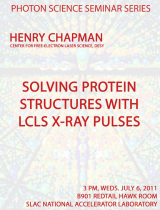Speaker: Henry Chapman, Free-Electron Laser Science (DESY)
Program Description
The ultrafast pulses from X-ray free-electron lasers have opened up a new form of protein nanocrystallography. The X-ray pulses are of high enough intensity and of sufficiently short duration that individual single-shot diffraction patterns can be obtained from a sample before significant damage occurs. This “diffraction before destruction” method may enable the determination of structures of proteins that cannot be grown into large enough crystals or are too radiation sensitive for high-resolution crystallography at synchrotron sources. Ultrafast pump-probe studies of photoinduced dynamics can also be studied. We have carried out experiments in coherent diffraction from protein nanocrystals at the Linac Coherent Light Source (LCLS) at SLAC. The crystals are delivered to the pulsed X-ray beam in a continuously flowing liquid jet. Millions of diffraction patterns were recorded at the LCLS repetition rate of 120 Hz. These are indexed, and combined into a single crystal diffraction pattern, which can be phased for structure determination and analyzed for the effects of pulse duration and fluence. We have obtained molecular images of samples including the Photosystem I membrane protein complex, and a glycosolated protein that formed micro-crystals inside cells.
Experimental data collection was carried out as part of a large collaboration involving CFEL DESY, Arizona State University, Max Planck Institute for Medical Research, University of Uppsala, SLAC, LBNL, and LLNL.





